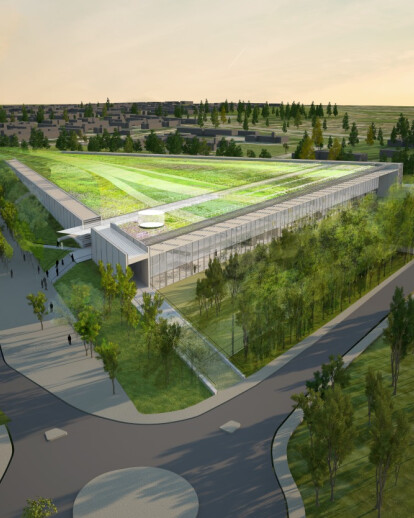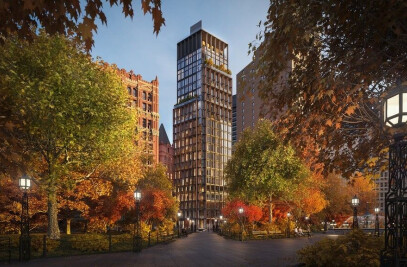The Musée du Louvre and the Nord-Pas de Calais region have announced the winner of the competition to build a conservation and storage facility for the Musée du Louvre in Liévin in northern France (Nord-Pas-de-Calais). The project has been granted to a consortium consisting of the British architecture firm Rogers Stirk Harbour + Partners, the consortium’s representative and best known for the British Museum’s new World Conservation and Exhibitions Centre in London (2014); the French firm Mutabilis Paysage (landscape architects); Egis Bâtiments Nord (technical consultancy); Inddigo SAS (environmental consultancy); and VPEAS SAS (economists).
Richard Rogers was awarded the Pritzker Architecture Prize in 2007.
The consortium designed a 20,000 m2 landscape building, with a slightly sloping roof, fully covered with vegetation. Understated and elegant, it combines light-filled spaces for people to work and art to circulate, and cutting-edge technology to guarantee stable climatic conditions for the proper conservation of the Louvre’s collections. Functional and accessible, the new building will welcome scientists and researchers from end-2018. Construction is set to begin in 2017. The construction budget mounts to 35 million euros, and the overall cost of the project 60 million euros. The Musée du Louvre will finance 51% of the project, and the regional council of Nord-Pas de Calais 49%.
Approximately 250,000 works of art, currently stored in more than 60 different locations both inside and outside the Louvre palace (in Greater Paris and other French regions), will be transferred to the site as soon as the building is complete. The artworks will therefore be in one sole location, in the immediate vicinity of the Louvre- Lens. Transferring the museum’s reserve collections is a step aimed at protecting the art from the risk of centennial flooding. The move is intended to create a facility for study and research—one of Europe’s largest—to enhance the scientific renown of the Musée du Louvre.
Jean-Luc Martinez, President-Director of the Musée du Louvre “The consortium of architects, headed by Rogers Stirk Harbour + Partners, has succeeded in taking the specific needs of properly preserving and accessing the Louvre’s collections, and turning them into a first-class architectural creation. The project proposes innovative solutions in terms of sustainable development and the building’s thermal mass. It is particularly commendable for providing a response that is perfectly in line with the plan to ensure stable climatic conditions for storing art, and for the organization of day-to-day interactions in a one-story space. The architects also had people in mind when designing this light-filled space nestled in nature, taking into consideration the comfort level of the personnel who will work there, conducting research on the works of art. The new facility will be in perfect dialogue with its neighbor, the Louvre-Lens.”
Daniel Percheron, President of the Nord-Pas-de-Calais region “The project for a conservation and storage facility, designed by a Franco-British team, is in line with the threefold vision of the Nord-Pas-de-Calais region, with the support of Euralens: a cultural facility with the creation of the Musée du Louvre-Lens; economic renewal with the support of centers of excellence, notably in relation to the art and culture economy and art professions; and lastly, an environmental dimension with the onset of the “third industrial revolution.”
“The building is nestled in nature, becoming one with the landscape.” It is our intent that the new conservation and storage facility for the collections of the Musée du Louvre tap into the full potential offered by our project’s functional program and its location as a natural extension of a green pathway. Our proposal calls for a sloping design in harmony with its surroundings, to provide a discreet solution for a building surface area of considerable scope, following the natural contours of the site. The new, inclined surface takes the diverse volumes of the collections into account organically, protecting them from extreme fluctuations of the outdoors, in a building with high thermal mass to ensure stable and optimal conditions indoors.
The western edge of this new park is designed to highlight the all-important conservation work of the Louvre’s exceptional collection in the most up-to-date facilities. A large window offers a view onto the activity that will take place in a broad band that serves as an interface with the collections in the heart of the building. A garden on the same level provides a welcome oasis, pleasant views and natural light to personnel. This area is connected to the collections via the “boulevard of artworks,” a logistical axis linking the reception area to the art reserves and delivery bay. This ample flow of movement constitutes the core of the building, bathing conservation areas in natural light and providing a space brimming with life, thanks to its capacity to host activities, but also temporary and social events.
The structure of the building emerges from the landscape like the work of Vauban, the traditional strength of concrete walls framing the geological mass of the landscape. Two partitions create two main avenues for the flow of traffic, and determine the distribution of networks. They are discreet, do not obstruct ventilation of underground areas, and are the only visible parts of this built environment. The frame of the structure, simple and incremental, serves to define and unify all of the spaces, creating volumes that make up the whole of the site to offer great flexibility for future developments. This fundamental structure creates a series of linear vaults, generating spaces with a unique atmosphere. The end result is reminiscent of cathedral reliquaries, highlighting the value of the precious objects housed here.
The economy of means used in the project is a reflection of a well thought-out and elegant simplicity. The seamless blending of the building into the landscape, and the carefully conceived single-story plan are at once perfectly contemporary and timeless. This state-of-the-art facility, fully integrated into the surrounding landscape, offers an ideal place for works of art that are both priceless and ageless.

































